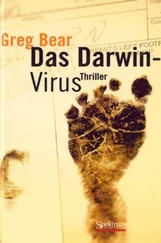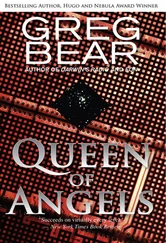As he fixed breakfast, the phone rang again. It was Eileen Ripper.
When Mitch finished speaking to her, he sat for a moment on the ragged chair in the living room, then stood and looked out the window at Broadway. It was getting light outside. He opened the window and leaned out. People were walking up and down the street, and cars were stopped at the red light on Denny.
He called home. His mother answered.
35
The National Institutes of Health, Bethesda
”It’s happened before,” Dicken said. He broke a sweet roll in half and dunked it into the foamy top of his latte. The huge modern cafeteria of the Natcher Building was nearly empty at this hour of the morning, and served better food than the cafeteria in Building 10. They sat near the tall tinted glass windows, well away from the few other employees. “Specifically, it happened in Georgia, in Gordi, or nearby.”
Kaye’s mouth made an O. “My God. The massacre…” Outside, sun broke through low morning clouds, sending shadows and bright patches over the campus and into the cafeteria.
“Their tissues all show SHEVA. I only got samples from three or four, but they all had it.”
“And you haven’t told Augustine?”
“I’ve been relying on clinical evidence, fresh reports from hospitals…What in hell difference would it make if I put SHEVA back a few years, a decade at most? But two days ago I got some files from a hospital in Tbilisi. I helped a young intern there make some contacts in Atlanta. He told me about some people in the mountains. Survivors of another massacre, this one almost sixty years ago. During the war.”
“Germans never got into Georgia,” Kaye said.
Dicken nodded. “Stalin’s troops. They wiped out most of an isolated village near Mount Kazbeg. Some survivors were found two years ago. The government in Tbilisi protected them. Maybe they were fed up with purges, maybe…Maybe they didn’t know anything about Gordi, or the other villages.”
“How many survivors?”
“A doctor named Leonid Sugashvili made it his own little crusade to investigate. It was his report the intern sent me — a report that was never published. But pretty thorough. Between 1943 and 1991, he estimated, about thirteen thousand men, women, and even children were killed in Georgia, Armenia, Abkhazi, Chechnya. They were killed because somebody thought they spread a disease that caused pregnant women to abort. Those who survived the first purges were hunted down later…because the women were giving birth to mutated children. Children with spots all over their faces, with weird eyes, children who could speak from the moment they were born. In some villages, the local police did the killing. Superstition dies hard. The men and women — mothers and fathers — they were accused of consorting with the devil. There weren’t that many of them, over four decades. But…Sugashvili estimates there might have been instances of this sort of thing going back hundreds of years. Tens of thousands of murders. Guilt, shame, ignorance, silence.”
“You think the children were mutated by SHEVA?”
“The doctor’s report says that many of the women who were killed pleaded that they had cut off sexual relations with their husbands, their boyfriends. They did not want to bear the devil’s offspring. They had heard about the mutated children in other villages, and once they had their fever, their miscarriage, they tried to avoid getting pregnant. Almost all the women who had the miscarriages were pregnant thirty days later, no matter what they did or did not do. Just as some of our hospitals are reporting now.”
Kaye shook her head. “That is so completely unbelievable!”
Dicken shrugged. “It’s not going to get any more believable, or any easier,” he said. “For some time now, I just haven’t been convinced that SHEVA is any known kind of disease.”
Kaye’s lips tightened. She put down her cup of coffee and folded her arms, remembering the conversation with Drew Miller in the Italian restaurant in Boston, and Saul saying it was time they tackle the problem of evolution. “Maybe it’s a signal,” she said.
“What sort of signal?”
“A code-key that opens up a genetic set-aside, instructions for a new phenotype.”
“I’m not sure I understand,” Dicken said, frowning.
“Something built up over thousands of years, tens of thousands of years. Guesses, hypotheses having to do with this or that trait, elaborations on a pretty rigid plan.”
“To what end?” Dicken asked.
“Evolution,” Kaye said.
Dicken backed his chair away and placed his hands on his legs. “Whoa.”
“You said it wasn’t a disease,” Kaye reminded him.
“I said it wasn’t like any disease I know. It’s still a retro-virus.”
“You read my papers, didn’t you?”
“Yes.”
“I dropped a few hints.”
Dicken pondered this. “A catalyst.”
“You make it, we get it, we suffer,” Kaye said.
Dicken’s cheeks reddened. “I’m trying not to turn this into a man-woman thing,” he said. “There’s enough of that going on already.”
“Sorry,” Kaye said. “Maybe I just want to avoid the real issue.”
Dicken seemed to reach a decision. “I’m stepping out of line by showing this to you.” He dug into his valise and produced a printout of an e-mail message from Atlanta. Four small pictures had been pasted on the bottom of the message.
“A woman died in an automobile accident outside Atlanta. An autopsy was performed at Northside Hospital, and one of our pathologists found she was in her first trimester. He examined the fetus, clearly a Herod’s fetus. Then he examined the woman’s uterus. He found a second pregnancy, very early, at the base of the placenta, protected by a thin wall of laminar tissue. The placenta had already started to separate, but the second ovum was secure. It would have survived the miscarriage. A month later…”
“A grandchild,” Kaye said. “Released by the…”
“Intermediate daughter. Really just a specialized ovary. She creates a second ovum. That ovum attaches to the wall of the mother’s uterus.”
“What if her eggs, the daughter’s eggs, are different?”
Dicken’s throat had grown dry and he coughed. “Excuse me.” He got up to pour himself a cup of water, then walked back between the tables to sit beside Kaye.
He continued, speaking slowly. “SHEVA provokes the release of a complex of polyproteins. They break down in the cytosol outside the nucleus. LH, FSH, prostaglandins.”
“I know. Judith Kushner told me,” Kaye said, her voice little more than a squeak. “Some of them are responsible for causing the miscarriages. Others could change an ovum substantially.”
“Mutate it?” Dicken asked, still clinging to the tatters of an old paradigm.
“I’m not sure that’s the right word,” Kaye said. “It sounds kind of vicious and random. No. We may be talking about a different kind of reproduction here.”
Dicken finished his cup of water.
“This isn’t exactly new to me,” Kaye mused quietly. She clenched her fingers into fists, then lightly, nervously, rapped her knuckles on the table. “Are you willing to argue that SHEVA is part of human evolution? That we’re about to make a new kind of human?”
Dicken examined Kaye’s face, her mixed wonder and excitement, the peculiar terror of coming upon the intellectual equivalent of a raging tiger. “I wouldn’t dare to put it so bluntly. But maybe I’m a coward. Maybe it is something like that. I value your opinion. God knows I need an ally here.”
Kaye’s heart thudded in her chest. She lifted her cup of coffee and the cold liquid sloshed. “My God, Christopher.” She gave a small, helpless laugh. “What if it’s true? What if we’re all pregnant? The whole human race?”
Читать дальше
Конец ознакомительного отрывка
Купить книгу












